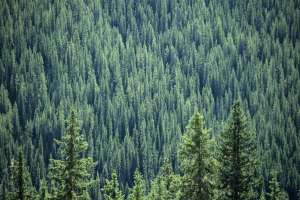
The Canadian boreal forest is a natural wonder—but it doesn't prevent warming. Credit: Photodisc / Getty Images
Deforestation is a major cause of climate change, responsible for perhaps 15% (PDF) of the world’s overall greenhouse gas pollution. That’s because trees sequester carbon, and when those trees are cut down or burned, they release that carbon back into atmosphere. And as we lose trees, we lose a valuable carbon sink—each year the Amazonian rainforest locks in an estimated 1.5 gigatons of carbon dioxide, without which we’d be living in a much hotter and less pleasant planet.
So: keep trees standing or even expand existing forests, and you can help stave off climate change. Right? Well, as it so often turns out in climate science, the reality on the ground is much more complicated. A new paper published in the November 17 Nature argues that deforestation actually has a net cooling effect when it’s carried out in the northern latitudes, largely because the open land left after a clearcut reflects sunlight, while dark forested ground tends to absorb solar energy.
Here’s Xuhui Lee, a meteorologist at the Yale School of Forestry and Environmental Studies and the lead author of the study:
More from TIME: Is Ecocide a Crime?
If you cut trees in the boreal region, north of 45 degrees latitude, you have a net cooling effect. You release carbon into the atmosphere by cutting down trees, but you increase the albedo effect—the reflection of sunlight.
The albedo effect is something you probably learned about in junior high science, and it’s something you can feel for yourself every time you go out in the hot sun in dark clothing. Usually when I’m writing about the albedo effect it’s to explain how the planet might be warming faster—as the Arctic ice cap melts, white snow that reflects sunlight is replaced by dark ocean that absorbs the energy, speeding warming.
But the opposite seems to be true on deforestation, at least at the high latitudes. The Nature researchers found that surface temperatures in open areas were cooler largely because white snow cover reflected the sunlight back into space, while forested areas absorbed that energy. And at night, open land cooled faster than forests, which forced warm air on the ground higher into the atmosphere.
More from TIME: Wildfires: They’re Not Just Dangerous to Trees
On the whole, the study authors found that temperature decreased by an average of 1.5 F in pen land north of the 45 degrees latitude, around the state of Minnesota. But as they looked further south, that cooling effect diminished, in part because forests in equatorial regions tend to hold more carbon—and therefore release more carbon when they’re cut down or burned. (Less extreme latitudes are also less likely to have snow-covered ground.) So the Nature researchers found that south of 35 degrees latitude, deforestation had a net warming effect.
This isn’t the first article to find that deforestation might actually help cool the climate. A 2007 study in the Proceedings of the National Academy of Sciences found that global-scale deforestation would result in a net cooling, as the changes in albedo and evaporation would overwhelm the impact of all that carbon being released into the atmosphere. But that doesn’t mean we should go about chopping down every tree we can—on the whole, preserving tropical forests and even adding more trees in the equatorial latitudes will be beneficial for the climate, not to mention the biodiversity that depends on rainforests. But large-scale reforestation or afforestation projects in the north may not be the best idea, as Lee says:
People are debating whether afforestation is a good idea in high latitudes. If you plant trees you sequester carbon, which is a benefit to the climate system. At the same time, if you plant trees you warm the landscape because trees are darker compared to other vegetation types. So they absorb solar radiation
The study is another reminder of just how devilishly complicated the climate system really is.
More from TIME: What’s Behind the Southeast Wildfires
Bryan Walsh is a senior writer at TIME. Find him on Twitter at @bryanrwalsh. You can also continue the discussion on TIME’s Facebook page and on Twitter at @TIME


